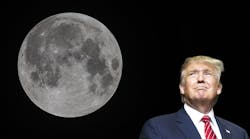President Donald Trump has directed NASA to send American astronauts back to the Moon and eventually to Mars, but eliminated his predecessors’ deadlines for such missions.
“This is a giant step toward that inspiring future and toward reclaiming America’s proud destiny in space,” Trump said Monday at a White House ceremony, where he signed the new NASA directive. “And space has to do with so many other applications, including a military application. So we are the leader, and we’re going to stay the leader, and we’re going to increase it many fold.”
Deputy White House press secretary Hogan Gidley said in a statement that the new policy reflects recommendations from the National Space Council, a White House advisory panel Trump appointed earlier this year. The White House didn’t provide details about how NASA’s work to return to the Moon would be funded, or whether any current programs would be cut.
The directive, released later in the day, changes a single paragraph in an 18-page memo President Barack Obama issued in 2010.
Obama had called for NASA to begin “crewed missions beyond the Moon, including sending humans to an asteroid” by 2025 and to “send humans to orbit Mars” by the 2030s. Trump’s directive orders NASA instead to “enable human expansion across the solar system,” “lead the return of humans to the Moon” and follow that with “human missions to Mars and other destinations.” But he set no deadlines for the missions.
Scaled-Back Ambitions
NASA said in a statement that the new policy would scrap its mission to send humans to an asteroid.
It isn’t unusual for recent presidents to scale back their predecessors’ ambitions for space exploration. President George W. Bush had called for NASA to return astronauts to the Moon by 2020, a mission that Obama ended out of cost concerns.
“This is the first step in a very long process,” John Logsdon, founder and former director of the Space Policy Institute at George Washington University, said in an interview. “The crucial next step is: Is there money for returning to the Moon in the budget? It’s been 45 years since we’ve been to the Moon, and a lot of people have a lot of ideas."
Marco Caceres, a space analyst with defense and aerospace consulting firm Teal Group, said “there’s not a lot of meat on” presidential directives to NASA, given that they haven’t been accompanied with specific funding proposals since the Apollo era, when America was racing to beat the Soviet Union in space.
“I don’t think simply an order to NASA is going to do anything unless it is accompanied by a notable increase of NASA’s budget — and by notable I mean a doubling or a tripling or a quadrupling of NASA’s budget,” Caceres said.
Russian Dependence
The U.S. retired the space shuttle program in 2011, three decades after it began. During the program’s span, the five shuttles flew 135 missions. Since the program ended, the U.S. has been forced to rely on Russian rockets, at the cost of $70 million per seat.
In September, Trump nominated Representative Jim Bridenstine, a Republican from Oklahoma, to be the next NASA administrator. Bridenstine, who if confirmed would be the first elected official to head the agency, is known as an advocate for bringing private companies such as Elon Musk’s Space Exploration Technologies Corp., or SpaceX, into NASA’s operations.
SpaceX launches rockets for customers including NASA, commercial satellite operators and the American military. On Wednesday, the closely held company is slated to fire off a Falcon 9 rocket and Dragon spacecraft laden with cargo supplies destined for the International Space Station, in what will be the company’s 17th mission of the year. Musk, 46, served on Trump’s early advisory councils until June, when he parted ways with the administration over Trump’s decision to pull the U.S. out of the Paris climate agreement.
After the shuttle program ended, NASA turned to private industry to fill in the gap. SpaceX and Boeing both have billion-dollar contracts to send American astronauts to the space station, with the first key tests of the technology slated for 2018. Musk has also announced plans to send paying tourists on flights around the Moon.
Astrobotic, a Pittsburgh-based startup that spun out of Carnegie Mellon University, praised Trump’s announcement, urging NASA to rend robotic landers to the Moon starting in 2020 in advance of a human return.
The Commercial Spaceflight Federation, which represents companies like SpaceX and Virgin Galactic Ltd., also applauded Trump’s action in an emailed press release.
“The U.S. commercial space industry has invested hundreds of millions of dollars in private capital to develop innovative capabilities for lunar transport, operations and resource utilization,”said Eric Stallmer, the group’s president, who added that the administration should direct NASA to better use that private investment to achieve the goals of the directive.
By Jennifer Jacobs and Dana Hull, with assistance from Justin Bachman, Alan Levin and Jennifer Epstein



